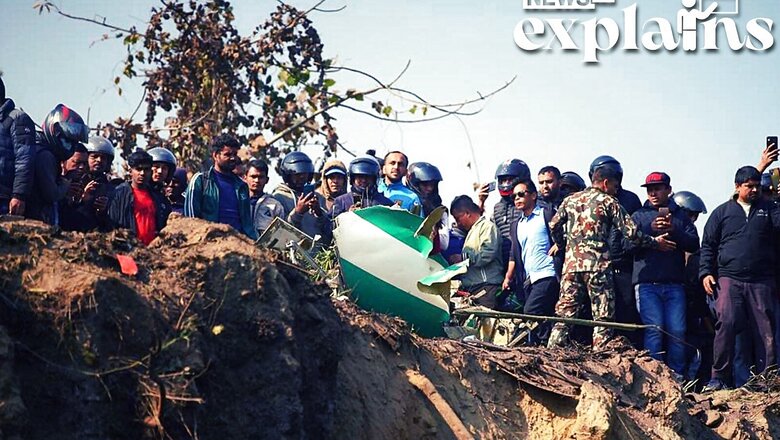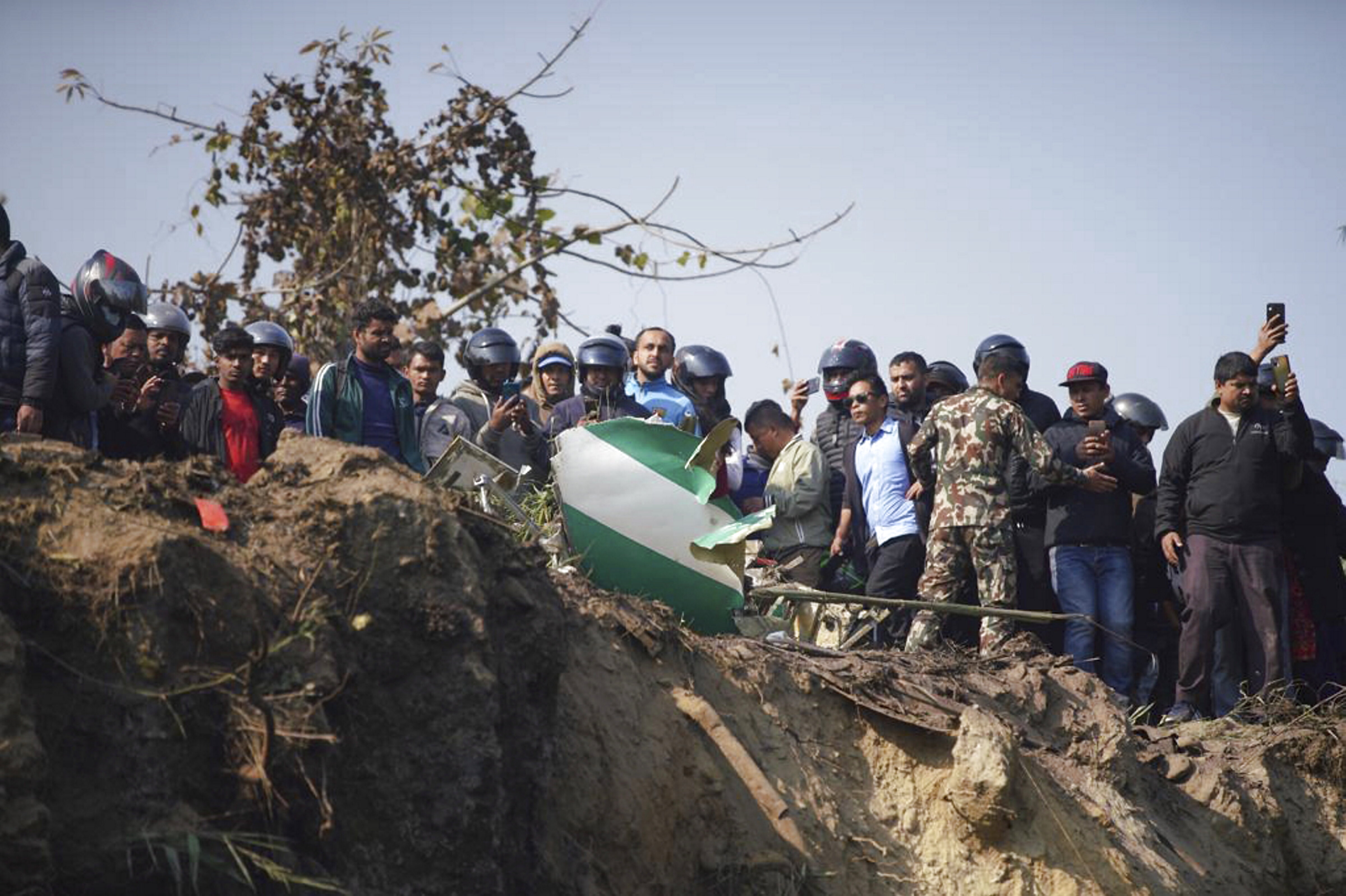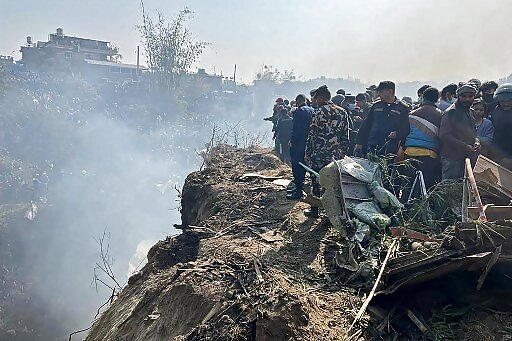
views
At least 45 people were killed and all are feared dead after a Nepalese passenger plane with 72 people, including 10 foreigners, onboard crashed into a river gorge on Sunday while landing at the Pokhara airport, according to media reports.
According to the Civil Aviation Authority of Nepal (CAAN), Yeti Airlines? 9N-ANC ATR-72 aircraft took off from Kathmandu?s Tribhuvan International Airport at 10:33 am. Pokhara is a major tourist destination in the Himalayan nation. While landing at the Pokhara airport, the aircraft crashed on the bank of the Seti River between the old airport and the new airport. There were a total of 68 passengers and four crew members, Republica newspaper reported.
An ATR-72 plane of Yeti Airlines crashed today near the Pokhara Airport while flying from Kathmandu. According to the info provided by Civil Aviation Authority of Nepal, 5 Indians were travelling on this flight. Rescue operations are underway. pic.twitter.com/rkLC3QbStn? IndiaInNepal (@IndiaInNepal) January 15, 2023
There were five Indians on board, sources said and at least 32 bodies have been recovered from the wreckage site, The Himalayan Times newspaper reported.
Nepal has had a fraught record of aviation accidents, partly due to its sudden weather changes and airstrips located in hard-to-access rocky terrains.
First visuals of plane that crashed during landing at Nepal's Pokhara airport with 72 people on board. @ridhimb with details Exclusive input: @manojkumargupta @toyasingh | #Nepal #NepalPlaneCrash pic.twitter.com/P5BJoyS5Z5
? News18 (@CNNnews18) January 15, 2023
The last major air accident in Nepal happened on May 29 when all 22 people onboard, including four members of an Indian family, were killed as a Tara Air plane crashed in Nepal?s mountainous Mustang district.
Why Does Nepal See So Many Air Crashes?
According to a report by Financial Express, Air crashes in Nepal are mostly caused by the country?s rugged mountainous terrain, a lack of investment in new planes and infrastructure, and lax regulation.
Furthermore, the airstrips are located in mountainous areas, amid weather conditions known for their abrupt changes. The European Union banned all Nepal-based airlines from flying in its airspace in 2013, citing safety concerns. The Kathmandu Post has reported that the Nepal government?s failure to act had ensured that the European Union aviation blacklist remained in place.
Over the last 30 years, there have been 27 fatal plane crashes in Nepal, the Indian Express reports, citing Aviation Safety database. More than 20 of these have occurred in the last decade.

Smaller planes with turboprop engines, such as the recently crashed Twin Otter, can land here, but not larger jetliners. According to the report, these smaller planes are more vulnerable to strong weather conditions in Nepal.
What Can be Done?
On May 30, 2022, a missing Tara Air jet was discovered wrecked on a hillside. All 22 passengers on board the plane were discovered dead. This is one of several fatal plane crashes in Nepal over the last three decades on the Pokhara-Jomsom route.
After the incident, UK publication the Guardian talked to experts on what went wrong and what more could be done to make flying safer in Nepal. “More can be done. For example, the older aircraft don’t have modern weather radars. That could be mandated so the captain has real-time weather information for what he is flying into,” Ashok Pokharel, president of the Nepal Association of Tour Operators told the Guardian.
According to the report, the Tara jet had its first flight in 1979. It did not have GPS technology, which the pilot could have used in low visibility and possibly saved lives.

He said the Stol aircraft is dangerous to be flying in a place like Nepal due to its lack of technology.
The report further says that the frequency of crashes have raised questions about whether pilots involved in low-altitude crashes in Nepal have the information and technology they need to avoid mistakes before and during flights. Dr. Archana Shrestha, a senior meteorologist with the Nepali government told the Guardian that they were unable to provide the required operational weather service for domestic flight routes operating at less than 10,000 feet.
At Nepal?s Tribhuvan international airport, significant investment has been made in meteorological observation and forecasting for international travel. Domestic services, on the other hand, have lagged behind, with pilots frequently relying on observations from airport weather stations, the report explains. Shrestha adds that in addition to airport construction, the government should spend more on aviation meteorological institutional development and service delivery.
Some Notable Plane Crashes
One of Nepal?s First Crashes
On August 1, 1962, a Douglas DC-3 operated by then-Royal Nepal Airlines crashed in Nepal while flying from Gaucher Airport (Tribhuvan International Airport today) to Palam Airport (Indira Gandhi International Airport today) in India. The plane?s wreckage, registered 9N-AAP, was discovered in Nepal near Tulachan Dhuri. It was one of Nepal?s first plane crashes, says a report by Online Khabar.
All ten passengers and four crew members were killed in the disaster. According to the official investigation, the aircraft veered off course while flying under instrument meteorological conditions and attempted to reach an altitude where it could resume flying under visual flight rules before colliding with a mountain at 11,200 feet (3,400 m).
Thai Airways Plane Crash
Thai Airways International Flight 311 was flying from Thailand?s Don Mueang International Airport to Tribhuvan International Airport on July 31, 1992. The Airbus A310-304, registered HS-TID, crashed as it approached Tribhuvan International Airport.
The captain and air traffic controller?s lack of situational awareness of linguistic and technical challenges are said to have increased the workload. The first officer?s lack ?inconclusive responses? to the captain?s concerns were revealed to be due to his inexperience, poor command of English, and reluctance to intervene with what he considered flying considerations such as terrain separation, the report explains, adding this particular incident taught the Nepali aviation sector many lessons.
Royal Nepal Airlines Crash
A Royal Nepal Airlines de Havilland Canada DHC-6 Twin Otter crashed on its way from Bajhang Airport to Dhangadhi Airport on July 27, 2000. It was also one of the plane crashes in Nepal that killed all of the passengers and crew members (25). When the disaster scene was discovered, Nepali officials launched an investigation into the collision. The plane crashed into trees on the 4,300-foot Jarayakhali Hill in the Sivalik Hills of Jogbuda, Dadeldhura, and caught fire. Everyone was killed in the crash, including three crew members and 22 passengers, three of whom were small children.
Yeti Crash
Yeti Airlines Airliner 103 was a domestic Nepali flight that crashed on October 8, 2008, on its final approach to Tenzing-Hillary Airport in Lukla, eastern Nepal. The 9N-AFE De Havilland Canada DHC-6 Twin Otter Series 300 took off from Kathmandu?s Tribhuvan International Airport. According to reports, up to 14 of the fatalities were vacationers.
The trip included 12 Germans and two Australians. Surendra Kunwar, the plane?s captain, was the only one who survived. He was pulled from the wreckage immediately after the accident and flown to Kathmandu for emergency treatment. Because there are no instrument landing systems at Lukla, the pilot lost visual contact due to severe weather and high fog.
The aircraft came in too low and too far to the left, causing it to crash short of the runway when the landing gear became entangled in an airport perimeter fence.
With inputs from agencies
Read all the Latest Explainers here















Comments
0 comment